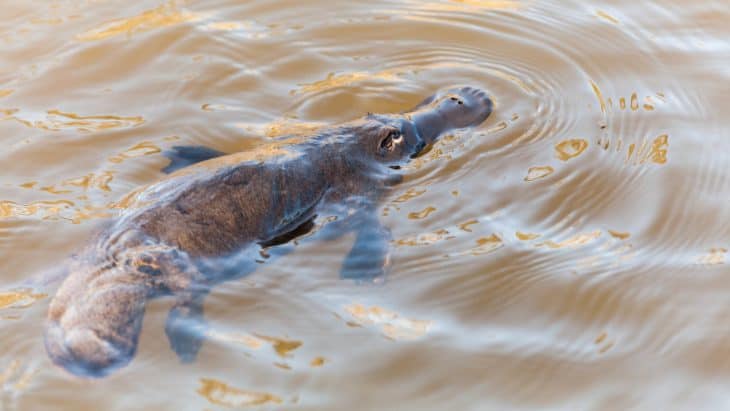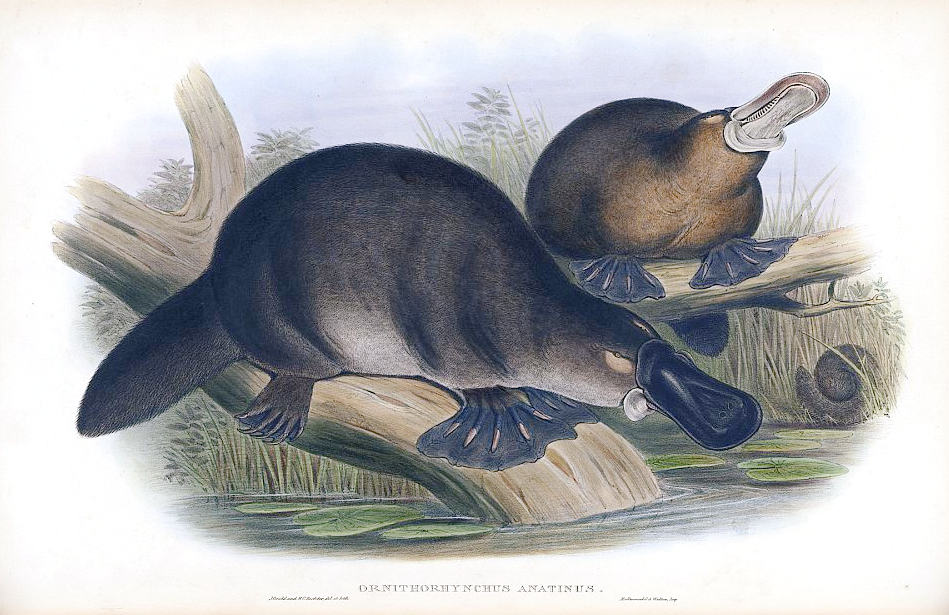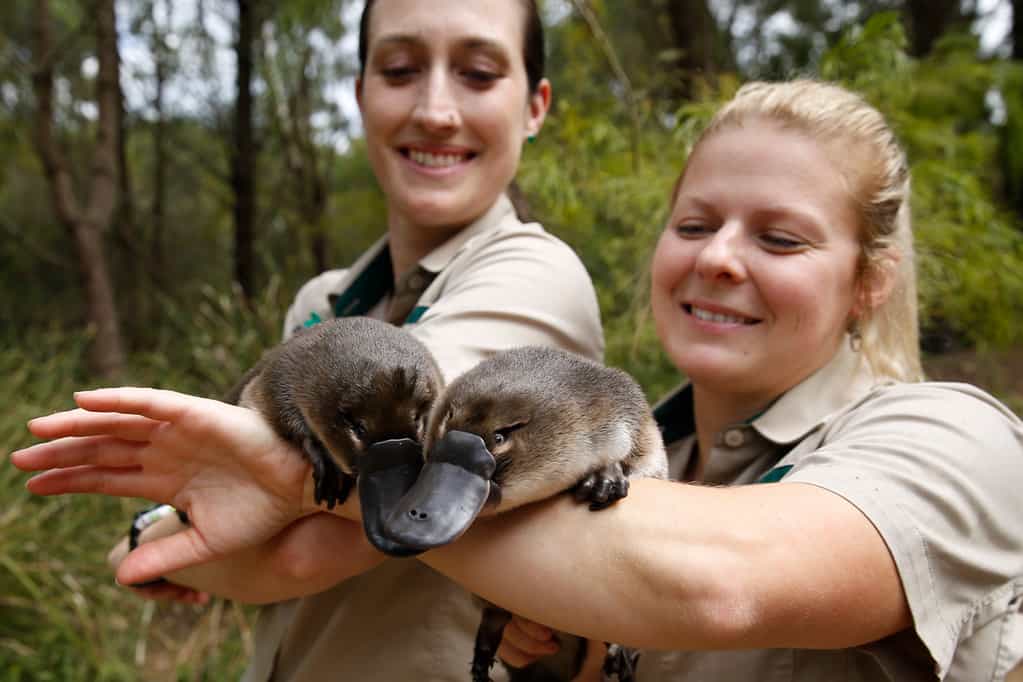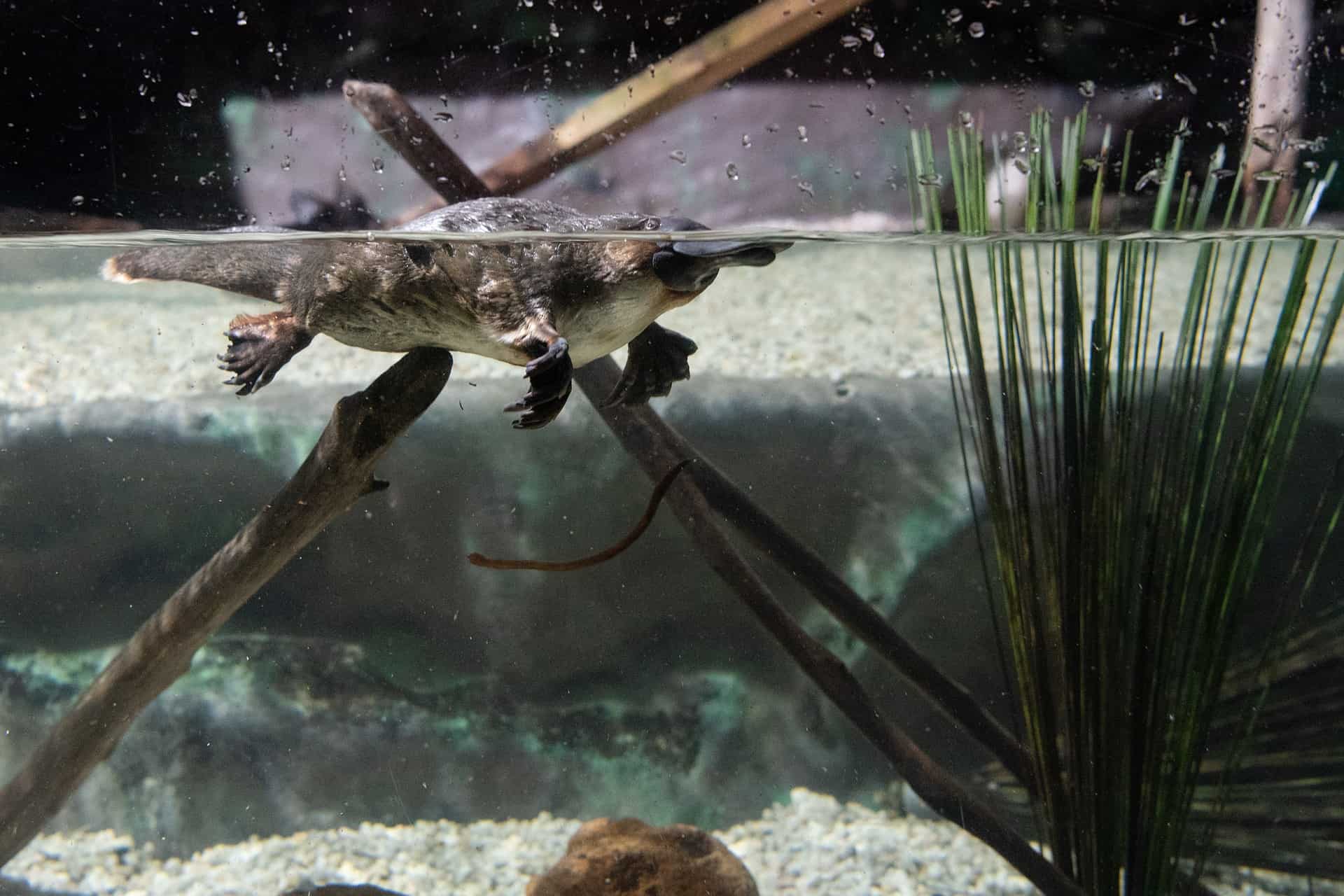
At first glance, the platypus seems like a strange remix of the animal kingdom. With the bill of a duck, the tail of a beaver, and the fur of an otter, even scientists didn’t believe they were real. Since their discovery, experts have struggled to figure out how platypuses work. However, there’s more to them than their strange features. Learn more about these odd animals with these interesting platypus facts.
- Platypuses weigh around 1.5 to 5.3 lbs (0.7 to 2.4 kg).
- Male platypuses have an average total length of 20 in (50 cm).
- Female platypuses grow to an average total length of 17 in (43 cm).
- The Europeans that colonized Australia first encountered the platypus in 1798.
- Platypus eggs hatch after 10 days.
- Platypuses are semi-aquatic mammals.
- They live near lagoons, streams, and rivers.
- Platypuses are warm-blooded animals.
- Baby platypuses are called puggles.
- The scientific name of the duck-billed platypus is Ornithorhynchus anatinus.
- It is the only living species of the genus Ornithorhynchus.
- Duck-billed platypuses do not have external ears.
- The platypus is the state mammal and animal emblem of the Australian state of New South Wales.
- They only have one breeding season per year, typically between the months of June and October.
- The name “platypus” originates from the Greek word platupous, which means “flat-footed”.
- Egg-laying mammals make up one of the three main groups of mammals, the others being placental mammals and marsupials.
- Platypuses emit low growling sounds when threatened.
- The Pokemon Psyduck and Golduck draw inspiration from platypuses.
- In the animated show Phineas and Ferb, the titular characters have a pet platypus named Perry the Platypus.
- Although female platypuses have two ovaries, only the left ovary is functional.
Platypuses locate their prey using electrical signals.
Unusual anatomy aside, one of the platypus facts that sets them apart from other mammals is their ability to detect electrical impulses. Out of all mammals, only egg-laying mammals (monotremes) and one species of dolphin has this special sense called electroreception. Through sensing electrical signals generated by muscle contractions, platypuses can determine their prey’s location.
Platypuses detect electrical signals through specialized receptors on the skin of their bills. Their bills also have an abundance of touch receptors that give the platypuses a strong sense of touch. Since they mostly use their bills to locate prey, platypuses usually shake their heads from side to side when they dive. Among all existing monotremes, platypuses have the strongest sense of electroreception.
They are one of the few mammal species that lay eggs.
One of the oddest platypus facts is that despite being mammals, they lay eggs like birds and reptiles. To date, only five existing species of mammals lay eggs: the four species of echidnas, and the platypus. Until 1884, it wasn’t confirmed whether the platypus laid eggs.
Collectively, these egg-laying mammals are referred to as monotremes. Although they lay eggs, they are genetically closest to mammals and have the essential characteristics that define mammals. Monotremes have fur, three bones in the middle ear, and a neocortex. They also feed their young through mammary glands, which is the most distinctive aspect of being a mammal.
Platypuses don’t have stomachs.
If you’re looking for bizarre platypus facts, here’s one for you: they don’t have stomachs. Surprisingly, other monotremes such as the echidnas don’t have them either. While most jawed vertebrates evolved with stomachs, platypuses, echidnas, and many species of fish lost their stomachs through their evolutionary history.
At some point in time, platypuses and other stomach-less species moved past the need for stomachs, but the reason remains unclear. Some experts suggest that these species had diets that simply did not need the help of enzymes to break them down.
Meanwhile, others contended that platypuses ate a lot of acid-neutralizing compounds such as the calcium carbonate in shellfish. This rendered the stomach acids useless, and they similarly did not need stomachs anymore. Whatever the reason may be, we have to stomach the fact that platypuses and echidnas can thrive without these acid-secreting digestive organs.
Male platypuses have venomous spurs.
The duck-billed platypus is one of the few mammals that can produce venom. Both male and female platypuses have spurs on their ankles, but only the spurs of male platypuses have venom.
Platypus venom is strong enough to kill dogs and other small animals. Although it isn’t lethal to humans, it can be excruciating enough to seriously impair a person. The pain reportedly can last for months on end and give the person a heightened sensitivity to pain. Generally, platypus venom causes nausea, edema, cold sweats, and chronic pain that can’t be treated by painkillers.
Since the males’ glands produce more venom during the breeding season, experts suggest that platypuses use these spurs to assert the dominance against competitors.
Platypus venom could help scientists create an effective treatment for diabetes.
It may be harmful, but platypus venom could potentially help scientists create a treatment for type 2 diabetes, as it contains a long-lasting form of the compound glucagon-like peptide-1 (GLP-1 ). A naturally-occurring compound, GLP-1 can stimulate the release of insulin, helping lower blood glucose levels. With enough research, scientists could possibly harness this venom for medical uses.
Early scientists thought that platypuses were fake.
The duck-billed platypus is such an odd animal that it’s hard to believe that they’re real. One of the most interesting platypus facts is that early scientists thought the platypus was a hoax made of different animals put together.It all started when the second Governor of New South Wales, Captain John Hunter, sent a sketch and a pelt of the animal back to Great Britain. Dumbfounded by its unique anatomy, the scientists thought that the platypus was just an elaborate hoax.
In 1799, the zoologist George Shaw wrote the first scientific description of the platypus. Shaw mentioned that it was indeed not impossible to believe that the platypus was carefully constructed as a prank. To confirm, he even checked the dried pelt of the platypus for stitches, only to find that the animal was real.

The English plural of “platypus” isn’t agreed upon.
With all the different variations, you might have asked yourself, “What is the plural form of platypus?” Common plural forms of platypus in English include platypuses, platypi, platypodes, or simply platypus. Despite this variety, many experts disagree on the usage. That said, there is no unanimous opinion on the correct plural form of platypus.
Most scientists write “platypuses” or “platypus.” In this sense, “platypodes” would also be correct, as this plural form traces back to the Greek origin of the word “platypus.” Although popular in common usage, “platypi” is a form of pseudo-Latin, which may not be readily accepted by experts.
Platypuses only live in a small area in Australia.
Endemic to some areas in Australia, the duck-billed platypus can’t be found anywhere else in the world. Typically, platypuses live near bodies of freshwater in New South Wales, eastern Queensland, Victoria, and Tasmania. They are more prevalent in coastal areas in eastern Australia, while their inland populations remain unknown.
Platypuses are carnivores.
They may not look like it, platypuses have a carnivorous diet. To hunt for prey, platypuses dive and forage at the bottom of water forms, where they eat an assortment of animals. Platypuses mostly eat aquatic invertebrates, such as shrimps, annelid worms, crayfish, and insect larvae. When available, they would also eat small fish and fish eggs. How’s that for essential platypus facts?
They store their food in special cheek pouches.
Similar to squirrels and chipmunks, platypuses also have cheek pouches where they store food for a short while. Platypuses don’t immediately swallow their prey, but instead temporarily store food in pouches at the back of their jaws. Once they rise to the surface of the water, they would consume what they gathered. Certainly one of the cutest platypus facts.
Platypuses also use their tails for carrying objects and nesting their eggs.
Female platypuses have the sole responsibility of caring for her offspring, warming her eggs by placing them between her tail and her body. She also uses her tail to build her nest, carrying wet leaves and reeds to her burrow using her curled-up tail.
Platypuses swim with their front feet and steer with their back feet.
As semi-aquatic creatures, platypuses spend most of their time in the water, it’s only natural that they are excellent swimmers. Perhaps one of the lesser-known platypus facts is that they propel themselves with their webbed front feet and steer with their back feet and tail. How’s that for interesting platypus facts?
They only dive for a short amount of time.
Although platypuses have a number of adaptations that help them live a semi-aquatic lifestyle, they don’t typically spend much time underwater. They only dive for about 30 seconds, spending 10 to 20 seconds breathing before each consecutive dive. Although they can dive for longer than 30 seconds, few of them exceed more than 40 seconds underwater.
They use their tails as fat reserves.
The broad, flat, beaver-like tails of platypuses serve many different functions. Like beavers and Tasmanian devils, platypuses use their tails as fat reserves. That said. they store fat in their tails to use as emergency energy sources in times of starvation.
Female platypuses don't have nipples.
One of the most popular platypus facts is that they don’t have teats from where their young can suckle. Instead, they release milk from pores in their mammary glands, giving the popular notion that platypuses “sweat” milk.When female platypuses lactate, the milk pools in natural grooves in their bodies, where the puggles can lap the milk up. From there, young puggles would suckle up to four months after hatching.

Platypuses don’t have teeth.
Although adult platypuses don’t have teeth, they actually hatch with one pair of premolars and two pairs of molar teeth. However, their baby teeth drop out around the time they leave the breeding burrows. In their place, adult platypuses grow hard, keratinized pads that help them mechanically crush their food.
Some experts suggest that they ingest small rocks to assist them in crushing their food, but other scientists claim this phenomenon as merely accidental.
Their thick fur helps keep them warm.
Similar to otters, platypuses have thick, dense coats of waterproof fur. Their fur traps air underneath them, which keeps water away from their skin and provides insulation to keep them warm.
Duck-billed platypuses have undercoats which comprise around 900 hairs per square millimeter of their skin. Above this coat, they have longer, coarser guard hair covering their bodies.
They are solitary animals.
Duck-billed platypuses are not social animals and only meet up to mate. They are solitary and notoriously shy even among themselves, especially the males. The territories of males frequently have overlapping areas, and the male platypuses avoid each other by having “shifts” of foraging times.
They diverged from other mammals around 19–48 million years ago.
The oldest fossil record of modern platypuses date back to 100,000 years ago, but their ancestors split from other mammals much earlier. According to scientists, monotremes branched off from early mammals before the separation of placental mammals and marsupials. Currently, scientists estimate that platypus ancestors may have diverged from echidnas around 19–48 million years ago.
Platypuses defecate, urinate, and reproduce through a single opening.
Aside from egg-laying, platypuses have cloacas similar to birds and reptiles. Like these animals, platypuses urinate, defecate, and reproduce through this opening. In fact, the word “monotreme” stems from the Greek term for “single opening.”
They sleep for around 14 hours a day.
Duck-billed platypuses don’t do much but sleep for most of the day. On average, platypuses sleep up to 14 hours a day. Platypuses also have the longest known rapid-eye movement (REM) sleep among all animals, spending around 5.8 to 8 hours a day in REM sleep. Although most dreams in humans occur in REM sleep, it is unclear whether or not platypuses dream.
One of the most adorable platypus facts is that they curl up when they sleep, wrapping their furry tails around their heads and bills. This position helps keep them warm throughout the night. However, platypuses don’t sleep like this in warmer environments.
Platypuses can live up to 17 years in captivity.
Because of their elusiveness in their natural habitats, little is known about their lifespan in the wild. Some researchers report that they live up to 12 years in the wild, but they can live as long as 17 years in captivity.They live shorter lives in the wild mainly due to environmental dangers such as predation and water pollution. Their natural predators include humans, feral dogs, foxes, and birds of prey such as owls and eagles.

Platypuses are primarily active at night and at dusk.
Duck-billed platypuses are mainly nocturnal and crepuscular, meaning they are most active during the night and at twilight. However, they can also become active during the day, especially if the sky is dark. Because of their excellent sense of touch and electroreception, they do not need night vision that many nocturnal animals have.
They have 10 sex chromosomes.
Another one of the oddest platypus facts is that they have 10 sex chromosomes, compared to humans which have only two. Not only this, but platypus DNA even has traits similar to those of birds and reptiles.
Platypus eggs are leathery, similar to reptile eggs.
Despite what their bills may suggest, the eggs of platypuses don’t have the hard, calcified shells of bird eggs. Instead, they have leathery coverings like reptile eggs. Also similar to reptiles, only part of the egg divides during its development. Before laying, platypus eggs develop inside the female platypuses for around 28 days.
They knuckle-walk like gorillas and anteaters.
Platypuses have extensive webbed digits on their feet that help them swim and maneuver efficiently through the water. On land, walking with these webbed feet can be quite awkward. To prevent themselves from stumbling on their large webbed feet, platypuses walk on their knuckles like gorillas and anteaters.
Bedtime stories of indigenous Australians feature the platypus.
As a native Australian animal, the indigenous peoples of Australia have many Dreamtime stories that feature platypuses. According to these stories, platypuses are a cross between water rats and ducks. In one of the stories, water animals, land animals, and birds all competed for the platypus to join their faction.
However, the platypus declined all of their invitations because it felt that it didn’t need to be a part of their groups to feel special. Now there’s one for interesting platypus facts.
Platypuses used to be hunted for their fur.
From the 19th to the 20th century, humans had a high demand for platypus fu, hunting them for commercial purposes. Among other products, humans used platypus fur to make coats, hats, rugs, and slippers. It was only until 1912 that Australia enforced a nationwide ban on platypus hunting.
There are four main platypus population groups in Australia.
According to genetic studies of platypus populations, four main groups of platypuses exist in Australia. These distinct population units reside in central Queensland, north Queensland, New South Wales and Victoria, and Tasmania and King Island. To prevent invasive tendencies, these platypus varieties are separated by geographic barriers that don’t allow the populations to interbreed.
As a consequence, they have distinct genetic differences, but not enough to warrant separation into different species.
Platypus populations are declining.
The exact conservation status of platypuses is still a subject of debate because they are so elusive, but their populations seem to be declining due to the presence of humans. They still occupy most of the ranges they inhabited since their discovery by Europeans, but their populations in South Australia have gone extinct.
Fortunately, conservation efforts have been successful and experts deem them vulnerable but not in immediate danger of extinction.
Was this page helpful?
Our commitment to delivering trustworthy and engaging content is at the heart of what we do. Each fact on our site is contributed by real users like you, bringing a wealth of diverse insights and information. To ensure the highest standards of accuracy and reliability, our dedicated editors meticulously review each submission. This process guarantees that the facts we share are not only fascinating but also credible. Trust in our commitment to quality and authenticity as you explore and learn with us.


